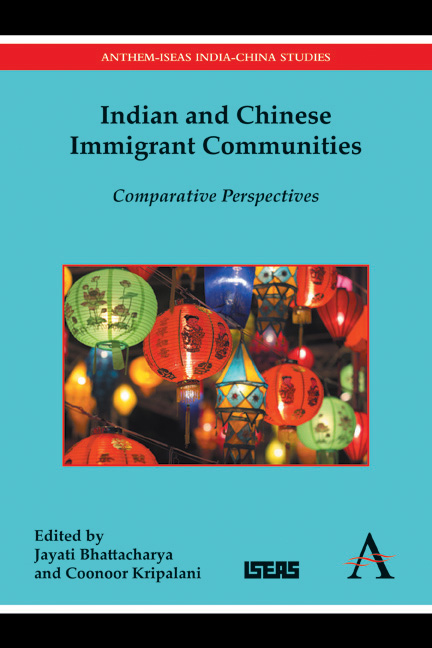Book contents
- Frontmatter
- Contents
- Foreword
- Acknowledgements
- Introduction
- Section I Historical Antecedents and the Question of Nationality
- Section II The Meeting Ground: Indians and Chinese in Southeast Asia
- 4 China's Nationality Laws and the Chinese Overseas
- 5 A Comparison of the Home Remittance Systems of Indian and Chinese Migrants in Southeast Asia: Nineteenth and Twentieth Centuries
- 6 Identity, Transnationalism and Corporate Development: Chinese Business in Malaysia
- 7 Beyond the Glitterati: The Indian and Chinese Jewellers of Little India, Singapore
- 8 Indian and Chinese Communities in Contemporary Burma: A Comparative Analysis of Their Presence and Influence
- 9 Expressions of Faith in Hindu Processional Festivals: Case Studies from Singapore and Malaysia
- 10 Beyond Boundaries? Hindu Spaces in the Chinatowns of Kolkata and Singapore
- Section III Indians in China and Chinese in India
- Section IV Across the Globe: Indian and Chinese Diasporas
- Postscript Shifting Worlds and Changing Identities: The Reshaping of the Chinese-Indian Communities in India after the 1962 “Sino-Indian Incident”
- List of Contributors
- Index
10 - Beyond Boundaries? Hindu Spaces in the Chinatowns of Kolkata and Singapore
from Section II - The Meeting Ground: Indians and Chinese in Southeast Asia
Published online by Cambridge University Press: 05 December 2015
- Frontmatter
- Contents
- Foreword
- Acknowledgements
- Introduction
- Section I Historical Antecedents and the Question of Nationality
- Section II The Meeting Ground: Indians and Chinese in Southeast Asia
- 4 China's Nationality Laws and the Chinese Overseas
- 5 A Comparison of the Home Remittance Systems of Indian and Chinese Migrants in Southeast Asia: Nineteenth and Twentieth Centuries
- 6 Identity, Transnationalism and Corporate Development: Chinese Business in Malaysia
- 7 Beyond the Glitterati: The Indian and Chinese Jewellers of Little India, Singapore
- 8 Indian and Chinese Communities in Contemporary Burma: A Comparative Analysis of Their Presence and Influence
- 9 Expressions of Faith in Hindu Processional Festivals: Case Studies from Singapore and Malaysia
- 10 Beyond Boundaries? Hindu Spaces in the Chinatowns of Kolkata and Singapore
- Section III Indians in China and Chinese in India
- Section IV Across the Globe: Indian and Chinese Diasporas
- Postscript Shifting Worlds and Changing Identities: The Reshaping of the Chinese-Indian Communities in India after the 1962 “Sino-Indian Incident”
- List of Contributors
- Index
Summary
This paper brings together two comparative contexts, situated in South and Southeast Asia, for the study of interactions between Indian and Chinese communities, particularly through the presence of Hindu spaces in the Chinatowns of Kolkata (formerly known as Calcutta) and Singapore. It locates the space of interaction in two Hindu temples in the Chinatowns – a Kali temple in Kolkata and the Mariamman Temple in Singapore – and analyses the history and practices of interaction between the communities in these spaces within two areas of wider theoretical concern. Firstly, the paper interrogates the idea of Chinatowns as closed and bounded spaces. Intra-ethnic interactions in Chinatowns are generally perceived in terms of the neighbourhood being “consumed” and becoming the space of the other, and focus on how these spaces have a visual imagery of the exotic and forbidden. Moving beyond the racialized processes that are often behind the creation of Chinatowns in Western cities, and also the notion of the neighbourhood as a singular space, this paper presents a comparison of two Chinatowns in Kolkata and Singapore. While interactions across religious traditions also occur in spaces and sites beyond Chinatown, this paper highlights the interactions within this space to destabilize a unified and singular image of Chinatown, and also to argue that the idea of Chinatown itself plays a role in influencing these interactions. Secondly, the paper situates the comparative contexts of Kolkata and Singapore within recent concerns about highlighting the importance of “other global cities.” In contrast to economic and financial flows that have been the focus of Saskia Sassen's idea of “global city,” The Other Global City situates the Asian city as part of the topography of interconnected regions, and focuses on everyday forms of interactions and cosmopolitanisms. Yet there are considerable variations within these “other global cities.” Through a focus on the Hindu temples as sacred spaces in Chinatowns, this paper interrogates to what extent religion facilitates the creation of a “diaspora space” and whether these shared sacred spaces can be a suitable framework for comparison across Chinese and Indian immigrant communities.
- Type
- Chapter
- Information
- Indian and Chinese Immigrant CommunitiesComparative Perspectives, pp. 153 - 164Publisher: Anthem PressPrint publication year: 2015



